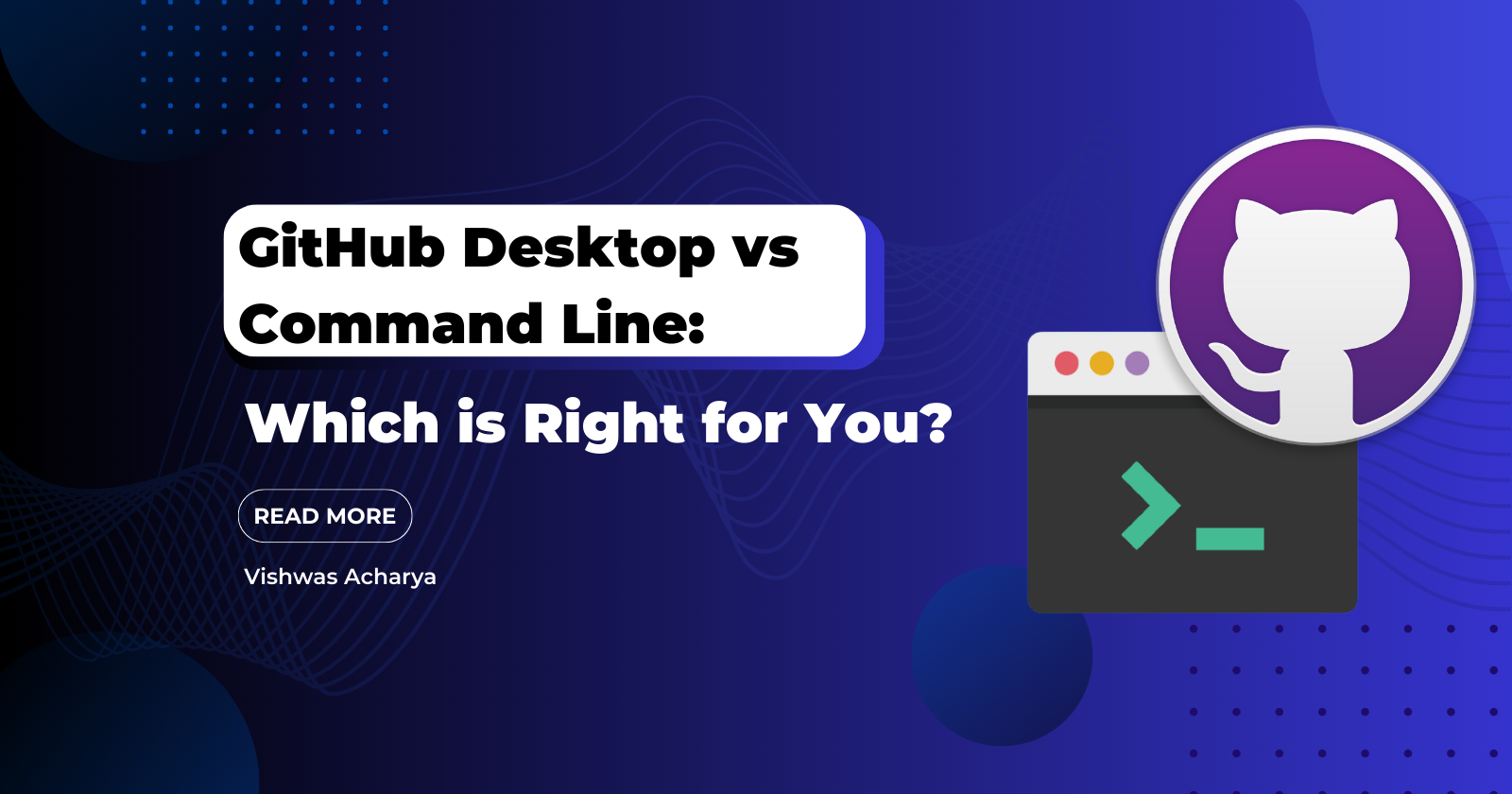GitHub Desktop vs Command Line: Which is Right for You?
 Vishwas Acharya
Vishwas AcharyaTable of contents

GitHub is a widely popular platform that developers use for version control and collaboration. It offers various tools and features to streamline the development process. Two commonly used methods for interacting with GitHub are the GitHub Desktop application and the command line interface (CLI). Both approaches have their advantages and can be suitable for different types of users. In this article, we will explore the differences between GitHub Desktop and the command line and help you determine which one is right for you.
Introduction
GitHub Desktop and the command line are two distinct ways to interact with GitHub repositories. While GitHub Desktop provides a user-friendly graphical interface, the command line allows for more fine-grained control and advanced functionality. Understanding the characteristics and differences between these two options is crucial for developers aiming to maximize their efficiency and productivity.
Understanding GitHub Desktop
GitHub Desktop is an application that simplifies the interaction with GitHub repositories through a visual interface. It offers an intuitive and user-friendly environment for managing version control tasks. With GitHub Desktop, you can clone repositories, create branches, commit changes, manage pull requests, and perform various other Git operations with ease. Its primary goal is to provide a streamlined experience for developers who prefer a graphical interface.
The Power of Command Line
In contrast to GitHub Desktop's visual approach, the command line interface (CLI) allows developers to interact with GitHub repositories using text-based commands. The CLI offers a more direct and flexible way to perform Git operations. It provides granular control over the repository, allowing for precise adjustments and advanced workflows. The command line is favored by experienced developers who value the command-driven nature of Git.
Ease of Use
GitHub Desktop is designed to be user-friendly, making it an excellent choice for beginners or developers who prefer a simplified interface. It eliminates the need to memorize Git commands and provides a visual representation of the repository's status and history. On the other hand, the command line has a steeper learning curve as it requires familiarity with Git commands. While it may take some time to grasp, the command line offers more control and flexibility once mastered.
Visual Interface vs. Text-Based Interface
GitHub Desktop's visual interface presents a clear representation of your repository's branches, commits, and changes. It provides an intuitive way to visualize the repository's history and track modifications. In contrast, the command line interface relies on text-based commands and displays the information in the terminal. This minimalistic approach appeals to developers who prefer a more direct and efficient workflow without the visual clutter.
Flexibility and Advanced Features
While GitHub Desktop covers the majority of everyday version control tasks, it may lack some advanced features available through the command line. The command line interface provides fine-grained control over the Git repository, allowing you to execute complex operations and automation scripts. If you require advanced functionality or want to incorporate Git into custom workflows, the command line is the way to go.
Collaboration and Integration
GitHub Desktop simplifies collaboration by providing an intuitive way to manage pull requests, merge changes, and resolve conflicts. It streamlines the process of working with team members and ensures a smooth collaborative workflow. The command line, on the other hand, offers the same collaboration capabilities but with the added advantage of being scriptable and customizable. It enables seamless integration with other tools and systems, making it ideal for complex development environments.
Workflow Efficiency
GitHub Desktop excels in scenarios where a visual interface and simplified workflows are preferred. It is particularly valuable for developers who prioritize efficiency in tasks such as cloning repositories, creating branches, and committing changes. The command line, while initially more complex, offers a higher level of efficiency when it comes to executing complex or repetitive tasks. Its flexibility and scripting capabilities enable developers to optimize their workflows and automate routine operations.
Learning Curve
GitHub Desktop minimizes the learning curve associated with Git by providing a user-friendly interface. It allows developers to start working with repositories quickly, without the need to memorize complex command structures. The command line, however, requires users to learn Git commands and their various options. Although it may take some time to become proficient, mastering the command line can significantly enhance your productivity and control over the Git ecosystem.
Choosing the Right Tool
When deciding between GitHub Desktop and the command line, consider your preferences, level of experience, and the nature of your development projects. If you are new to version control or prefer a visual interface, GitHub Desktop offers a straightforward and accessible solution. On the other hand, if you value control, flexibility, and advanced features, the command line provides a more powerful and customizable experience. Ultimately, you can even use both tools together, leveraging the strengths of each to optimize your workflow.
Conclusion
GitHub Desktop and the command line are two distinct approaches to interacting with GitHub repositories. GitHub Desktop offers a user-friendly graphical interface, simplifying version control tasks for beginners and those who prefer visual workflows. The command line interface provides granular control, advanced functionality, and flexibility for experienced developers who value precise control over Git operations. Choosing the right tool depends on your preferences, experience level, and project requirements.
FAQs
Q: Can I use both GitHub Desktop and the command line together?
A: Yes, you can use both tools together. GitHub Desktop can be used for visual interactions and simplified tasks, while the command line provides more advanced control and flexibility.
Q: Are there any limitations of GitHub Desktop?
A: GitHub Desktop covers the majority of everyday version control tasks, but it may lack some advanced features available through the command line interface.
Q: Does the command line offer better control over Git?
A: Yes, the command line interface offers finer control and more advanced functionality compared to GitHub Desktop.
Q: Can I switch between GitHub Desktop and the command line?
A: Yes, you can easily switch between GitHub Desktop and the command line based on your preferences and the specific requirements of your tasks.
Q: Which tool do experienced developers prefer?
A: Experienced developers often prefer the command line interface due to its flexibility, power, and ability to customize workflows.
By Vishwas Acharya 😉
Checkout my other content as well:
YouTube:
Podcast:
Book Recommendations:
Subscribe to my newsletter
Read articles from Vishwas Acharya directly inside your inbox. Subscribe to the newsletter, and don't miss out.
Written by

Vishwas Acharya
Vishwas Acharya
Embark on a journey to turn dreams into digital reality with me, your trusted Full Stack Developer extraordinaire. With a passion for crafting innovative solutions, I specialize in transforming concepts into tangible, high-performing products that leave a lasting impact. Armed with a formidable arsenal of skills including JavaScript, React.js, Node.js, and more, I'm adept at breathing life into your visions. Whether it's designing sleek websites for businesses or engineering cutting-edge tech products, I bring a blend of creativity and technical prowess to every project. I thrive on overseeing every facet of development, ensuring excellence from inception to execution. My commitment to meticulous attention to detail leaves no room for mediocrity, guaranteeing scalable, performant, and intuitive outcomes every time. Let's collaborate and unleash the power of technology to create something truly extraordinary. Your dream, my expertise—let's make magic happen! Connect with me on LinkedIn/Twitter or explore my work on GitHub.